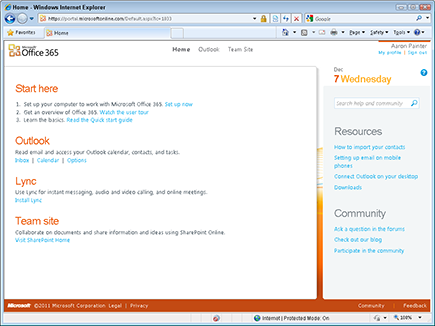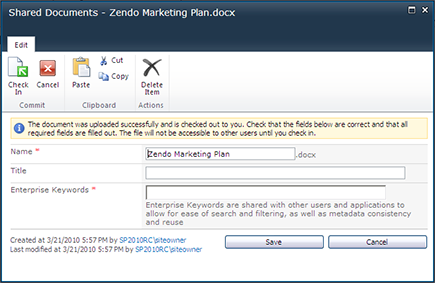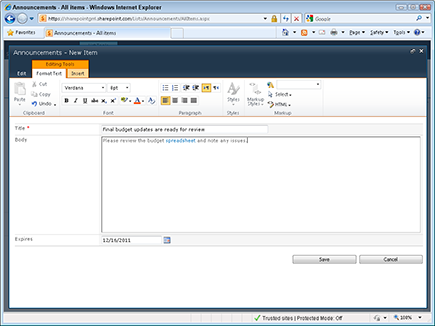Figure 1-1: A SharePoint team site home page.
Chapter 1
Getting to Know Your Team Site
In This Chapter
![]() Requesting a new team site and opening it in the browser
Requesting a new team site and opening it in the browser
![]() Participating in a team site
Participating in a team site
![]() Changing your team site’s home page
Changing your team site’s home page
One of the fundamental kinds of websites that SharePoint 2010 allows you to create is a team site. A team site is a SharePoint site that you can use to collaborate with your coworkers. If the team site is hosted in your company’s extranet or in the cloud by a public hosting service, such as Microsoft Office 365 SharePoint Online, you may even be able to collaborate with people outside your organization. In most cases, an administrator will create a team site for you.
Many kinds of teams can use a SharePoint team site to collaborate. For example:
![]() Department members can use document libraries to upload document files and enter meetings in a team calendar.
Department members can use document libraries to upload document files and enter meetings in a team calendar.
![]() Project members can use a team site home page to post announcements and track issues and risks.
Project members can use a team site home page to post announcements and track issues and risks.
![]() Corporate communications can use a team site to store the documents and track the tasks required for preparing the company’s annual report.
Corporate communications can use a team site to store the documents and track the tasks required for preparing the company’s annual report.
You need to know your way around some of the basic features of a team site, which is exactly what I show you in this chapter.
Requesting Your Team Site
Most organizations have a process for requesting a team site. I’ve seen everything from the simple process in which you send an e-mail addressed to someone in your IT department to very detailed wizards that walk you through the site creation process. One company requires that you write a justification for why you want the team site and then submit prototypes.
Whatever you have to do to get your SharePoint 2010 team site, get one. At a minimum, you need to provide your SharePoint administrator with this information to get a team site:
![]() The site name: The friendly caption that appears in the header of your site and in any site directory where your site may be listed.
The site name: The friendly caption that appears in the header of your site and in any site directory where your site may be listed.
![]() The site template: The template determines what kind of site SharePoint makes for you. SharePoint includes dozens of predefined site templates. Your company may even create its custom site templates. Tell your administrator you want a team site, which is the most popular of all the SharePoint 2010 site templates.
The site template: The template determines what kind of site SharePoint makes for you. SharePoint includes dozens of predefined site templates. Your company may even create its custom site templates. Tell your administrator you want a team site, which is the most popular of all the SharePoint 2010 site templates.
![]() The web address or URL: The unique location where your team site is hosted. In most organizations, all team sites are located off the same root web address. Some examples I’ve seen include
The web address or URL: The unique location where your team site is hosted. In most organizations, all team sites are located off the same root web address. Some examples I’ve seen include
http://intranet.company.com/sites
http://portal/projectsites
http://sharepoint/sites
I discuss the detailed steps of how to create a new site in Chapter 7. For now, I’m going to assume you have someone to create one for you.
Your organization may also ask who has permission to access the site. By default, all SharePoint team sites have three basic kinds of users, which are called SharePoint groups:
![]() Visitors have Read Only permission. They can view your site without making any contributions.
Visitors have Read Only permission. They can view your site without making any contributions.
![]() Members can participate in your team site by uploading and editing documents or adding tasks or other items.
Members can participate in your team site by uploading and editing documents or adding tasks or other items.
![]() Owners have Full Control permission to customize the site. As the person requesting the team site, the SharePoint administrator likely assumes that you’re the proud owner unless you specifically tell him who owns the site.
Owners have Full Control permission to customize the site. As the person requesting the team site, the SharePoint administrator likely assumes that you’re the proud owner unless you specifically tell him who owns the site.
You’ll need to decide which users fit into which of these three SharePoint Groups. SharePoint offers more than just these three groups, and you can create your own groups to meet your needs. I discuss SharePoint groups and permissions in more detail in Chapter 13.
Your site’s users must be connected physically to your network or have permission from your network administrator to access your network remotely. Some companies set up a special kind of deployment for SharePoint, or an extranet, that provides a secure way for non-employees to log in to their SharePoint team sites without actually being on the internal company network.
Setting up SharePoint in an extranet environment can be done in lots of ways. Configuring a SharePoint extranet in your company’s network can be complex and is outside the scope of this book. However, the good news is that SharePoint Online, which is part of the Office 365 suite, eliminates many of the technical barriers to creating an extranet. In Chapter 24, I walk you through the steps to use SharePoint Online to create an extranet for collaborating with clients.
Viewing Your Team Site in the Browser
To access your team site, you use a web browser, such as Internet Explorer, Google Chrome, or Mozilla Firefox. You need the web address or URL of your team site, which you can get from your SharePoint administrator. You also need a network user account with permissions to access the team site.
In my case, the web address for my team site is
To access your team site:
1. Open your web browser.
2. Type the web address for your team site in the address bar and press Enter.
Figure 1-1 shows the home page for a SharePoint team site.

All SharePoint team sites have the same features. If you’re using a new team site, your site should match the one in Figure 1-1. If your site has been customized, it may look slightly different. Never fear: All the same features are still there. You may just have to hunt a little bit to find them.
Your team site may not have the I Like It and Tags & Notes buttons in the upper right corner of the screen. You must have permission to use SharePoint 2010’s social features to see these buttons. I recommend asking your administrator to explore these features if they are currently disabled. I discuss the social features of SharePoint 2010 in more detail in Part III.
You can think of the SharePoint page as having the following major sections:
![]() Header: The header spans the entire top of the page. You can think of the header in a SharePoint page like the menu in a traditional Windows application, such as Microsoft Word. SharePoint 2010 even features the Ribbon in the page header, similar to how the Ribbon appears in the top of many Office applications.
Header: The header spans the entire top of the page. You can think of the header in a SharePoint page like the menu in a traditional Windows application, such as Microsoft Word. SharePoint 2010 even features the Ribbon in the page header, similar to how the Ribbon appears in the top of many Office applications.
![]() Left navigation pane: The navigation pane provides quick access to the site’s document libraries, lists, and discussion boards. You can even add links to content you create, such as documents and web pages.
Left navigation pane: The navigation pane provides quick access to the site’s document libraries, lists, and discussion boards. You can even add links to content you create, such as documents and web pages.
![]() Page content: The content displays in the body of the page.
Page content: The content displays in the body of the page.
Generally speaking, the header and left navigation pane stay fairly consistent, whereas the body of the page changes to display the content for the web page. This is very similar to how most websites work. For a more detailed explanation of the layout of a team site, see Chapter 8.
Accessing Team Sites in Office 365
Accessing a site that is hosted in Office 365 may be a little different than sites that are hosted on your network. You may access your site through the main Office 365 portal URL, which is http://portal.microsoftonline.com.
Depending on how your company has configured its connection with Office 365, you may not be prompted to log in to Office 365. However, in my experience, most small to medium size companies don’t bother integrating their logins, so you will probably have to use your Office 365 username and password, which will be different from your account for your internal network.
I discuss the pros and cons of integrating your network logins with Office 365 in Part VII.
Figure 1-2 shows an example of the login screen for Office 365. You may want check the boxes for Remember Me and Keep Me Signed In so you aren’t prompted continuously to log in to Office 365. You will still get prompted occasionally to change your password or verify your password.
Figure 1-2: Logging in to Office 365.

Figure 1-3 shows the Office 365 main portal page for a user who has access to all the features of Office 365. In addition to SharePoint Online, it includes Exchange Online, Lync Online, and Microsoft Office 2010 Professional Plus. If your subscription only covers SharePoint Online, you won’t see these other options.
You can click the Team Site link at the very top of the page or the Visit SharePoint Home link under the Team Site heading to reach your company’s default team site.
Alternatively, your administrator may give you the direct link to your team site. In that case, you would bypass the screen in Figure 1-3. However, you still have to log in to Office 365 if your company doesn’t have the logins integrated.
Figure 1-3: The main Office 365 portal home page.

Contributing to a Team Site
One of the main purposes of a team site is to allow its members to collaborate. But collaborate on what? Think of all the stuff that you do with Outlook and e-mail right now — all the documents you send as attachments, contacts you track, and messages you send with announcements. Now imagine doing all those same tasks in a website you share with your coworkers or project members.
Now take that one step further. Think about any public websites you use to network with other people, such as MySpace, LinkedIn, or Facebook. You can use your team site along with other features in SharePoint to create a community of people that you collaborate with at work.
Uploading documents
Most teams need to share documents. You probably use e-mail to send documents as attachments. With your new SharePoint 2010 team site, you can upload your files to the team site and send your team members a link to the document.
SharePoint 2010 uses a special kind of container — a document library — for storing files. Your team site has a document library dubbed Shared Documents where you can put documents you want to share with others. You can create additional document libraries and give them any name you want. See Chapter 2 for more details on working with files and document libraries in SharePoint 2010.
To upload a document to the Shared Documents library in your team site:
1. Click the Shared Documents link in the left navigation pane of your team site.
The Shared Documents library appears.
 You can click the All Site Content link in the left navigation pane to view a list of all the document libraries that you have permission to access.
You can click the All Site Content link in the left navigation pane to view a list of all the document libraries that you have permission to access.
2. Click the Upload Document button on the Documents tab of the SharePoint Ribbon.
The Upload Document window appears.
3. Click the Browse button and, in the Choose File dialog box, select a file to upload.
4. Click OK to upload the file to the document library.
When the file is uploaded, SharePoint displays the document’s properties in a new window, as shown in Figure 1-4.
5. Type the filename, title, and any keywords that you want to tag the document with in the Name, Title, and Enterprise Keywords text boxes, respectively.
See Chapter 2 for details on working with document properties.
6. Click the Save button to save the properties you’ve entered for the document.
The uploaded document appears in the document library.
Figure 1-4: SharePoint displays a document’s properties in a new window.

Making an announcement
Any time you upload a document or post content to your team site, I recommend getting into the habit of creating an announcement. Instead of firing off an e-mail telling co-workers you’ve just updated that spreadsheet, post an announcement. That way people can subscribe to the site’s announcement list (see Chapter 5) and automatically receive an e-mail notification.
To create a new announcement:
1. Click the All Site Content link in the left navigation pane.
The All Site Content page appears. This page displays all the lists, libraries, discussion forums, and sites you have permission to access.
2. Click the Announcements link in the Lists section to open the Announcements list.
You may have to scroll down to see the Lists section.
3. Click the Add New Announcement link.
4. In the Announcements dialog box, use the Title field to briefly summarize your announcement. Describe the announcement in more detail in the Body, as shown in Figure 1-5.
If you enter an expiration date for your announcement in the Expires field, the announcement will no longer appear display by default.
5. Click the Save button to save your announcement.
Figure 1-5: Use announcements instead of e-mail.

Social networking
SharePoint 2010 lets you do some exciting things with social networking, which is a fancy way of referring to ways that people can share ideas, insights, and information among groups of users, such as sharing links with your friends on Facebook.
For example, SharePoint 2010 lets you tag things so that you can find them later and that people with whom you share your tags and notes also can see them. So for example, if you find a document that you like and want to encourage others in your network to read, you can apply a tag to the document and then that tag is associated with you so others viewing your profile can see the tag.
To tag a document:
1. Browse to the library containing the document and then select the document using the check box in the list view, as shown in Figure 1-6.
Figure 1-6: Select a document to tag.

2. Click the I Like It button on the Document tab, as shown in Figure 1-7.
SharePoint briefly displays the Add Tag confirmation message, and the item is saved to your tags and notes, visible to your colleagues in your profile Tags and Notes tab.
Figure 1-7: Click the I Like It button.

I cover user profiles and social networking in detail in Part III.
To view your tags and notes:
1. Click the arrow beside your name in the upper-right corner of the page and choose My Profile from the drop-down list.
Your profile page displays.
2. Click the Tags and Notes tab, as shown in Figure 1-8.
In the Activities For section of the page, you see an entry for the tag you just entered.
3. Select the Make Private check box beside any activity so that only you can see it.
Now only you can see the item you marked as private.
Figure 1-8: The Tags and Notes profile page.

SharePoint 2010 has other social networking features in addition to tags; you can see some of them by exploring your profile, and I talk a little more about them in Chapter 17, too.
Customizing Your Team Site
Most teams want to change their team site right away. As the site owner, you’ll likely be asked to make these changes. Some of the changes you can make include adding and removing text and images from the home page and adding new lists and libraries. You can even change the site’s color scheme and logo, which I discuss how to do in Chapter 14.
For now, stick to changing the home page. Later chapters in this part walk you through the process of working with lists and libraries.
Introducing the Ribbon
The header of the SharePoint 2010 team site page boasts the Ribbon. The Ribbon was introduced in Office 2007 and is a convenient way to display many menu items in a small amount of screen space.
The Ribbon in SharePoint 2010 features menu items that are relevant to the kind of page you’re viewing, arranged in tabs. For example, the home page of a team site displays two tabs: Browse and Page. You find most of the menu commands you need to use on the Ribbon, and some Ribbon buttons contain drop-down lists. Figure 1-9 shows the Ribbon with the Page tab active and the Edit drop-down list displayed.
Figure 1-9: Use the Ribbon to access menu commands.

Modifying the home page
A SharePoint 2010 team site creates a home page that you can modify to better meet your team’s needs. You can add text or images, or display your announcements, tasks, or calendar items.
You must be logged in to your site as a user with permissions to modify the site’s pages. That usually means you need to belong to the site’s Members group.
To put the home page in Edit mode:
1. Browse to the home page of your team site and then click the Page tab in the Ribbon.
The Ribbon displays a set of editing options for the web page.
2. Click the Edit button in the Edit section of the Ribbon.
The page appears in Edit mode.
With the page in Edit mode, you can place your cursor anywhere inside the rectangular boxes in the page’s body to edit the content. For example, to change the default text that appears on the home page, with your page in Edit mode, do the following:
1. Place your cursor in front of the Welcome text.
2. Delete the placeholder text and type your new text.
3. Use the formatting options displayed in the Ribbon’s Format Text tab to apply changes to your text, such as changing the font and adding bullet points.
You can even apply styles, as shown in Figure 1-10.
Figure 1-10: Apply formatting changes to your text with the Ribbon.

 SharePoint 2010 provides tools for formatting and editing your text in the browser.
SharePoint 2010 provides tools for formatting and editing your text in the browser.
4. Click the Stop Editing button to save your changes.
To add a table, image, link, or Web Part to your home page:
1. Place your page in Edit mode by clicking the Edit button on the Page tab in the Ribbon.
2. Click the Insert tab on the Ribbon to display your insert options and then place your cursor on the page where you want to insert an item from the Ribbon.
 You must place your cursor inside one of the rectangular boxes within the page’s body.
You must place your cursor inside one of the rectangular boxes within the page’s body.
3. Click the button for the content item you want to add (see Figure 1-11):
• For a table, click the Table button and then select the number of rows and columns you want in your table.
• For an image, click the Image button and then select whether you want to upload the image from your local computer or from another web address.
• For hyperlinked text, click the Link button to add it to your page.
• For a Web Part, click the Web Part button to add it to your page. See Chapter 9 for more details on working with Web Parts.
4. Click the Edit tab and then click the Stop Editing button to save your changes.
Figure 1-11: Use the Ribbon to add links, images, and tables.


 Single sign-on is the name of the technology that enables your internal network login to be integrated with Office 365. As the name implies, you only have to sign into the network once to access all network services, regardless of where those services live.
Single sign-on is the name of the technology that enables your internal network login to be integrated with Office 365. As the name implies, you only have to sign into the network once to access all network services, regardless of where those services live.